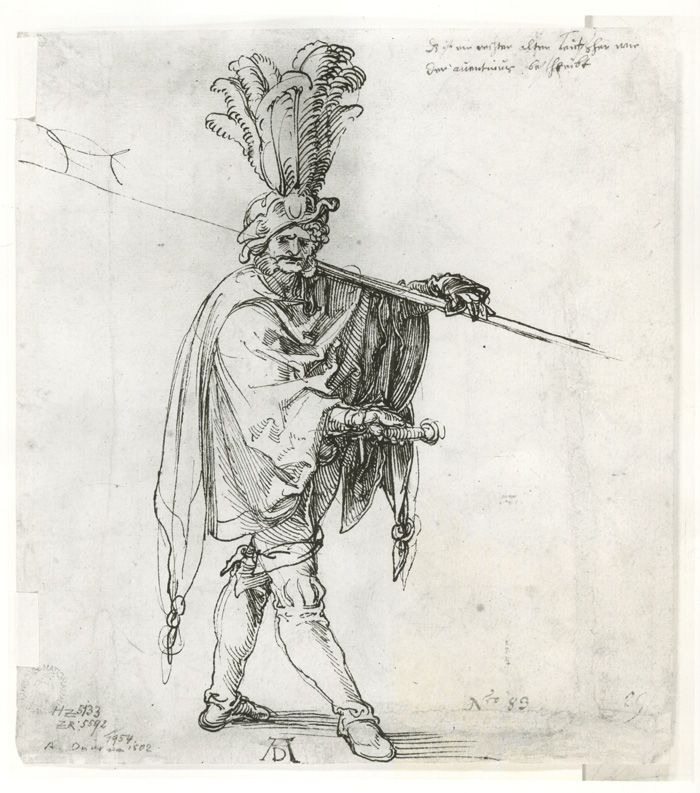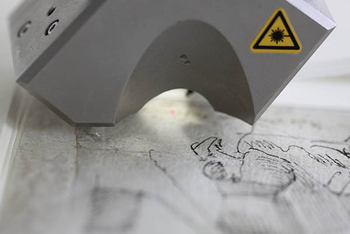Albrecht Dürer's early drawings
Non-destructive materials analysis of inks. Documentations of watermarks
Project duration: 01.09.2011 – 31.12.2012
Project sponsorship: DFG (German Research Foundation)-sponsored research project under the direction of the Germanisches Nationalmuseum, Nuremberg, with the participation of the Bundesanstalt für Materialforschung und –prüfung. Arbeitsgruppe Kunst und Kulturgutanalyse (Federal Institute for Materials Research and Testing. Workgroup „Art and Cultural Artifact Analysis“).
Development Proposal
The project sponsored by the Deutsche Forschungsgemeinschaft (German Research Foundation) is dedicated to the analysis of the inks and watermarks of early drawings by Albrecht Dürer. As with other artists, Dürer’s drawings often combine different drawing or writing materials on one sheet. Different inks were used for drawing and inscriptions. These material differences point to the process-oriented handling of the artwork, be it by Dürer himself, who retroactively optimized or systematized it, or by later collectors who left notations on the drawings. They may also indicate modern attempts at forgeries.
Until now scholars have interpreted such differences in media on a drawing subjectively, i.e. with the naked eye. Oeuvre catalogues comment on differences in regard to, for example, signatures or dates with “by another hand” or “in different ink”. Such statements are by nature subjective. Recent advances in art technology have made it possible to analyze historical inks without any interference with the drawing. X-ray fluorescence analysis and a specifically developed quantification routine determine an “elementary fingerprint“ of the drawing material.
By applying these technologies, the project examines approximately 50 early until now variedly interpreted Dürer sheets for their diversity of inks. The findings on the relationship between the drawing on the recto and verso, corrections, inscribed dates, signature, title etc. will provide new criteria for the discussion on authenticity, date and function of the respective sheet. Further visualisation processes will be devoted to watermarks.
Analysis of Iron Gall Ink with µ-RFA
The drawings to be examined must be executed in iron gall ink whose basic components are naturally found raw materials. Its inorganic components show – depending on a temporary, short term mixture – a heterogeneous compound: next to iron sulphate mostly copper, manganese, aluminium, and zinc sulphate. Thus its elementary composition is a specific characteristic, serving as distinctive property. The general type “iron gall ink” becomes an individual, time-limited drawing material in a tangible drawing whose different passages, corrections, inscriptions etc. indicate a chronologically homogenous origin (= one ink) or a process-oriented execution in stages (= different inks). The result of our examinationwould allow us to draw conclusions about (1) a chronologically homogenous origin, (2) an execution in stages, or (3) about one or several authors.
Methods for Measuring and Evaluation
The examination by means of micro-x-ray fluorescence analysis (µ-RFA) allows for a high energy resolvent, qualitative as well as quantitative elemental analysis down to the trace element. A 30-watt x-ray tube with molybdenum stimulation serves as excitation source. Through a polycapillary lens the primary radiation focuses on a spot to be measured of ca. 50 nm in diameter. The detection is carried out with an XFlash detector, an energy dispersive silicon drift detector with thermoelectric cooling. The instrument is conceived in such a way that one can take measurements from the air. The additional component of a helium flushing facilitates the detection of the so-called light elements (Z < 20) that normally are only accessible through vacuum measuring. The instrument is portable so that the examinations may be conducted in the drawings departments of the respective museums, i.e. the drawings do not have to leave the museum.
Subsequent follows an RFA analysis and classification of ink groups. Since the thicknesses of the inks on the paper differ, an absolute quantification of the chemical composition of the material is not always possible or only possible in a limited way. However, this is not strictly necessary for the differentiation of inks. Instead, the specification of relative concentrations of the secondary components in relation to the main components is sufficient. A so-called “fingerprint value” (Wi) may be indicated for the respective secondary component (i). If there are two or three such secondary components to be quantified in this manner, a differentiation of iron gall inks is entirely possible so that revisions, corrections and inscriptions may be distinguished from the original ink of the drawing (“primary drawing passages”).
On the History of Ink Analysis by means of µ-RFA
The idea to develop a procedure for the non-destructive analysis of black writing materials originated from a research project on the authograph manuscripts of Johann Sebastian Bach (2003) during the course of which the archaeometric characterization of iron gall ink by means of x-ray fluorescent analysis (= RFA) was developed. In the meantime, mostly famous autographs, such as those of Georg Büchner or Friedrich Nietsche, but also parts of the Dead Sea scroll fragments (Qumran Scrolls) or the autograph manuscript of the B-minor Mass by Johann Sebastian Bach have been examined.
By analyzing the iron gall inks in the so-called “Erfurter Bible” (Staatsbibliothek Berlin), the complex history of the creation of a medieval luxury manuscript could be reconstructed. Recently the procedure formed the central part of the project “Zu einer Typologie der niederländischen Zeichnung im 16. Jahrhundert” (“Towards a Typology of 16th-Century Dutch Drawings”) in the Kupferstichkabinett (Department of Prints and Drawings) in Dresden, also sponsored by the DFG. This is the first time that a larger, heterogeneous collection of drawings has been examined from an art-historical and material-technological point of view.
Analysis of Watermarks
Paying attention to watermarks is not new in Dürer research. Already in 1827 Joseph Heller pointed out the relation between watermarks and Dürer’s different creative periods. Dating based on watermarks depends on the similarities of the marks. If we find identical – or, with some modifications, similar – watermarks, the date of the actual use of a sheet may be transferred to the drawing with a tolerance period of plus/minus two to four years, determined by the period of usage of the wire sieves. Recently the first online watermarks databases have been created.
Until the middle of the 20th century, watermarks were mostly traced from the originals. However, deviations in such tracings frequently exceed the allowed, maximum “simple line strength”, i.e. they are imprecise. Mistakes also often occur in the copying of historic watermark motifs by scholars. Furthermore, the copying of the pure motif does not give us further information about the respective paper structure (variations in chain lines; intensity of ribbed lines; wire thickness; references to paper quality, as in knots and waterdrops). Over the last decades, a series of alternative processes in collecting watermarks have been developed whereby the image subtraction method developed at the Nederlands Interuniversitair Kunsthistorisch Instituut in Florence in connection with its watermarks database proved to be especially suitable. This method will be used in addition to the analysis of inks in early Dürer drawings.
Responsable
Dr. Thomas Eser
Iris Brahms M.A. (Werkvertrag)
Partners
PD. Dr. rer. nat. Oliver Hahn
leitet die Arbeitsgruppe Kunst- und Kulturgutanalyse der Bundesanstalt für Materialforschung und -prüfung in Berlin. Er besitzt eine langjährige Expertise in der Analyse historischer Zeichen- und Beschreibstoffe, insbesondere literarischer oder bildkünstlerisch wertvoller Dokumente.
Iris Brahms M.A.
legt derzeit an der FU Berlin ihre Doktorarbeit „wan an allen dingen ist lichts vnd finsters. Die nordalpine Tradition der Helldunkelzeichnung bis Albrecht Dürer“ vor. Sie war beteiligt an Ausstellungs- und Bestandskatalogen zur dürerzeitlichen Grafik in Berlin und Erlangen.
Dr. Georg Dietz
ist auf die Datierung von handgeschöpften und maschinengefertigten Papieren in Zusammenhang mit kunsthistorischen und kriminaltechnischen Fragestellungen spezialisiert. Er ist federführend beteiligt an Konzeption, Aufbau und Pflege moderner, web-basierter Wasserzeichenfindsysteme.
Further Objects

Information and Services
Plan Your Visit
Opening Times
Location and Approach
GNM Museum Shop
FAQ
Library
Branches
Contact


